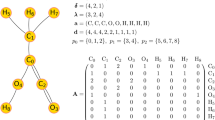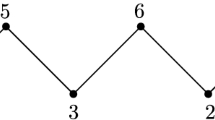Abstract
The concept of the mark of a permutation group is at least eighty years old, but comparatively little use has been made of it until recently. Redfield rediscovered marks in the 1930's, but his work was not published until 1984. He used them to count group reduced distributions according to their symmetry groups. In this paper, the Mark Version of Redfield's Superposition Theorem is used to count isomers. The method is compared with a related method used by Hässelbarth, Mead and Fujita.
Similar content being viewed by others
References
R.A. Davidson, J. Amer. Chem. Soc. 103 (1981)312.
J.H. Redfield, J. Amer. Math. Soc. 49 (1927)433.
E.K. Lloyd, Discr. Appl. Math. 19 (1988)289; reprinted in:Applications of Graphs in Chemistry and Physics, ed. J.W. Kennedy and L.V. Quintas (North-Holland, Amsterdam, 1988), p. 289.
W. Burnside,Theory of Groups of Finite Order, 2nd ed. (Cambridge University Press, London, 1911; reprinted: Dover, New York, 1955).
J.H. Redfield, J. Graph Theory 8 (1984)205 [written in 1940].
D.S. Schonland,Molecular Symmetry: An Introduction to Group Theory and its Uses in Chemistry (Van Nostrand, London, 1965).
D.M. Bishop,Group Theory and Chemistry (Clarendon Press, Oxford, 1973).
V. Krishnamurthy,Combinatorias: Theory and Applications (Ellis Horwood, Chichester, 1986).
H.O. Foulkes, Can. J. Math. 15 (1963)272.
C.A. Mead, J. Amer. Chem. Soc. 109 (1987)2130.
S. Fujita, various recent papers including: Theor. Chim. Acta 76 (1989)247; Bull Chem. Soc. Japan 63(1990)203; J. Math. Chem. 5(1990)99; 121.
W. Hässelbarth, Theor. Chim. Acta 67 (1985)339.
G. Pólya, Acta Math. 68 (1937)145; English translation in:Combinatorial Enumeration of Groups, Graphs and Chemical Compounds, ed. R.C. Read (Springer, New York, 1987), p. 1.
R.C. Read in:Combinatorial Enumeration of Groups, Graphs and Chemical Compounds ed. R.C. Read (Springer, New York, 1987), p. 96.
E.K. Lloyd, in:MATIPCHEM/COMP 1988, ed. A. Graovac (Elsevier, Amsterdam, 1989), p. 85.
J. Brocas, J. Amer. Chem. Soc. 108 (1986)1135.
J.I. Hall, E.M. Palmer and R.W. Robinson, J. Graph Theory 8 (1984)225.
W. Burnside, Proc. London Math. Soc. 34 (1901)159.
S. Fujita,Symmetry and Combinatorial Enumeration in Chemistry (Springer, Berlin, 1991).
A. Kerber,Algebraic Combinatorias via Finik Group Actions (B.I. Wiss., Mannheim, 1991).
Author information
Authors and Affiliations
Rights and permissions
About this article
Cite this article
Lloyd, E.K. Marks of permutation groups and isomer enumeration. J Math Chem 11, 207–222 (1992). https://doi.org/10.1007/BF01164205
Issue Date:
DOI: https://doi.org/10.1007/BF01164205




